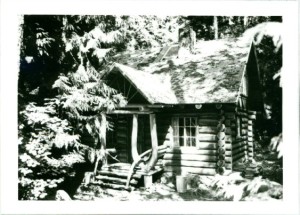Reminders of a special time in Oregon history when construction of privately owned “recreation residences” on federal land was used as a tool to encourage public use of the forest, the 550 highly desirable privately held cabins in and around Rhododendron, Oregon in the Mt. Hood National Forest are now recognized as excellent examples of rustic construction and National Forest recreation planning.
Construction of the cabins surged in the 1920s and 1930s, their lots platted and built to capitalize on the natural scenic value of the area. Cabin lots were aligned with streams, slopes, and natural features and were sited away from the road, and foliage that screened the cabins from highway noise and views could not be removed. The modestly-sized, rustic cabins incorporated native cedar, stone, and wood in roofs, chimneys, and siding. The booming economy after World War II signaled another surge in construction. In some post-war cabins the traditional rustic design was used, but new forms such as the A-frame and new materials such as aluminum windows and wood sheet siding appeared. Portlanders still used cabins to escape summer heat, but as interest in winter sports increased and vacation time became more variable, the former “summer cabins” became today’s year-round “recreation residences.”

Park Service
In the early 2000s, Mt. Hood National Forest and the Oregon State Historic Preservation Office (SHPO) identified three tracts and several individual residences in the Forest eligible to be listed on the National Register of Historic Places. The most well-known of these are the Steiner cabins, designed by Henry Steiner and famous for their rustic twisted wood features. By 2014, however, many postwar cabins had reached 50 years of age or were on the cusp of doing so, so they too became eligible for National Register listing. According to Forest historian Allie Wenzl, “the Forest Service is required to identify and evaluate historic properties…because of their age and because the cabins are located on federal lands.” The Forest reassessed its ten “rec res” tracts for National Register eligibility as recent past historic structures.
In January of this year, the Forest Service and SHPO found one additional tract of cabins to be National Register-eligible, another tract’s period of significance will be extended to include its postwar buildings, and several cabins have been deemed eligible for listing on the National Register individually as outstanding examples of A-frames and Northwest Regional styles (determined eligible for listing under what is known as a Multiple Property Documentation Form—providing history, background and context for a class or group of architecturally similar buildings).
Per National Forest policy, all of the National Register-eligible tracts and cabins will be managed as though they were on the National Register. Alterations and additions to National Register-eligible cabins will be subject to Forest Service design review, and their current and future owners will receive information and educational materials about their role as historic cabin holders. Historian Wenzl looks forward to the process, noting “the Forest Service and cabin owners work together on future project proposals in hopes of maintaining the historic character of the structures, which is what makes the cabin tracts so unique. We are grateful to the cabin owners who understand and follow our process. By following this process, cabin owners are preserving their cabins for future generations to enjoy.”
Tatum Clinton-Selin served as Heritage Survey Technician for Mt. Hood National Forest in 2014. Luckily, she enjoys history and being out-of-doors. She recently completed her master’s degree in historic preservation and relocated to Portland where she consults, volunteers and is a lead collaborator with the Vanport Multimedia Project.
One Reply to “Mt. Hood’s Historic Cabins Receiving Recognition”
Comments are closed.


Readers may enjoy this blog post by The Craftsman Bungalow on the Steiner Cabins which includes some beautiful images:
http://www.TheCraftsmanBungalow.com/steiner-log-cabin-on-mount-hood